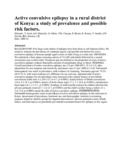| dc.description.abstract | BACKGROUND:
Few large-scale studies of epilepsy have been done in sub-Saharan Africa. We aimed to estimate the prevalence of, treatment gap in, and possible risk factors for active convulsive epilepsy in Kenyan people aged 6 years or older living in a rural area.
METHODS:
We undertook a three-phase screening survey of 151,408 individuals followed by a nested community case-control study. Treatment gap was defined as the proportion of cases of active convulsive epilepsy without detectable amounts of antiepileptic drugs in blood.
FINDINGS:
Overall prevalence of active convulsive epilepsy was 2.9 per 1000 (95% CI 2.6-3.2); after adjustment for non-response and sensitivity, prevalence was 4.5 per 1000 (4.1-4.9). Substantial heterogeneity was noted in prevalence, with evidence of clustering. Treatment gap was 70.3% (65.9-74.5), with weak evidence of a difference by sex and area. Adjusted odds of active convulsive epilepsy for all individuals were increased with a family history of non-febrile convulsions (odds ratio 3.3, 95% CI 2.4-4.7; p<0.0001), family history of febrile convulsions (14.6, 6.3-34.1; p<0.0001), history of both seizure types (7.3, 3.3-16.4; p<0.0001), and previous head injury (4.1, 2.1-8.1; p<0.0001). Findings of multivariable analyses in children showed that adverse perinatal events (5.7, 2.6-12.7; p<0.0001) and the child's mother being a widow (5.1, 2.4-11.0; p<0.0001) raised the odds of active convulsive epilepsy.
INTERPRETATION:
Substantial heterogeneity exists in prevalence of active convulsive epilepsy in this rural area in Kenya. Assessment of prevalence, treatment use, and demographic variation in screening response helped to identify groups for targeted interventions. Adverse perinatal events, febrile illness, and head injury are potentially preventable associated factors for epilepsy in this region | en |


